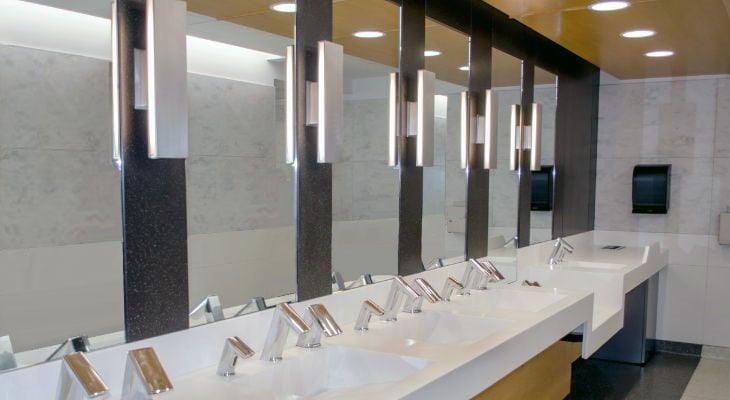
Top Restroom Requirements for Commercial Bathrooms
ADA Restroom Regulations
The American Disabilities Act (ADA) is a 30-plus-year-old law that protects the civil rights of disabled individuals from discrimination. Notably, the ADA also protects these rights in public and private settings, including schools, transportation, housing, commercial buildings, and more. Bathrooms are also covered by ADA regulations and must meet very specific requirements to ensure compliance.
First and foremost, every commercial restroom-regardless of size-must include an accessible stall with ADA-compliant fixtures and equipment. Toilet seats must be 17-19 inches from the ground, with 16-18 inches of space between the center line of the toilet and both walls of the stall. Additional space is necessary to accommodate wheelchairs (60 inches of clear circle space), and sidewall grab bars that are 36-42 inches are required. ADA-compliant flush valves must feature a user-friendly mechanism that doesn't involve grasping, wrist twisting, or finger pinching.
OSHA Restroom Requirements for Businesses
The Occupational Safety and Health Administration (OSHA) sets rules and regulations that protect the well-being of employees. While they're mainly known for their industrial standards relating to high-hazard working environments, OSHA also has rules regarding bathroom usage in commercial buildings. Mainly, employers must provide a sufficient number of water closets relative to their workforce. According to OSHA 1910.141(c)(1)(i):
- 1-15 Employees = 1 Water Closet
- 16-35 = 2
- 36-55 = 3
- 56-80 = 4
- 81-110 = 5
- 11-150 = 6
- 150+ = 1 additional water closet per 40 employees
OSHA also enforces standards relating to sanitation in commercial restrooms, including hot water requirements (1910.141(d)(1)) and handwashing considerations (1920.141(d)(2)(iii)).
OSHA Standards on Restricted Bathroom Access
There are a few OSHA restroom requirements relating to restricted bathroom access that every business must know, both during the design process of a commercial lavatory and throughout its operating life span. First and foremost, OSHA demands that all employees have open access to the restroom when they need it. Preventing this access through imposing unreasonable restrictions or failing to maintain a suitable restroom environment is immoral and illegal. Alternatively, bathroom keys, code locks, and other conditions cannot cause extended delays for the restroom user. Ultimately, these OSHA regulations ensure that employees can comfortably access a functional washroom as needed.

